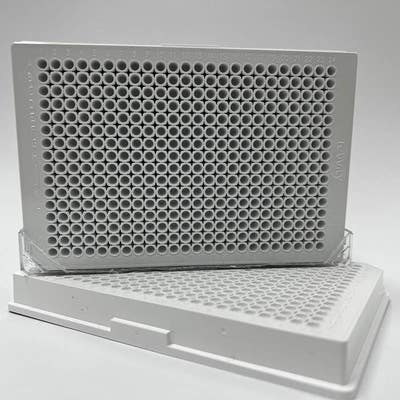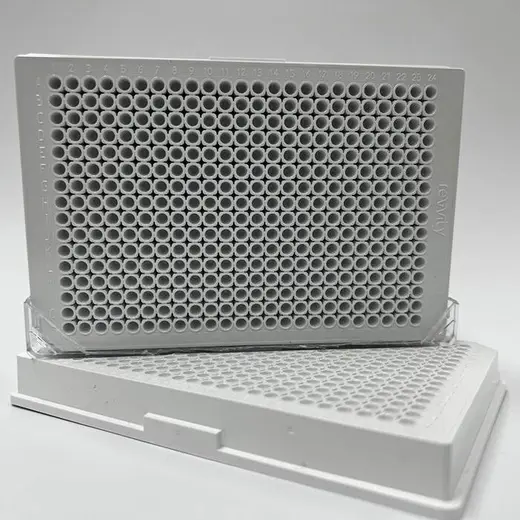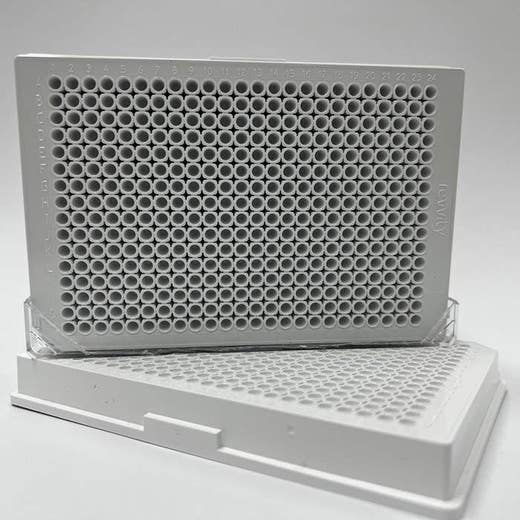
ProxiPlate 384-shallow well Plus, white, case of 200



| Feature | Specification |
|---|---|
| Surface Treatment | Untreated |
| Color | White |
| Detection Modality |
Alpha Luminescence Time-Resolved Fluorescence (TRF & TR-FRET) |
| Lids Included? | No |
| Material | Polystyrene |
| Sterility | Non-Sterile |
| Plate Format | 384 wells |
| Well Shape | Shallow-well |
| Well Volume | 28 µL |
| Working Volume | 10 - 20 µL |



Product information
Overview
ProxiPlate is Revvity's shallow-well microplate, offering closer proximity to analyzer's detectors. Designed to miniaturize your assay and utilize cost reduction advantages.
Leveraging years of assay and instrument experience in plate detection, Revvity designs better microplates better performance that guarantees better results all Revvity applications.
Packaging notes:
- Cases of 50 are packaged as 2 sleeves of 25 plates each. Each sleeve as 5 wraps with 5 plates.
- TC-treated cases of 50 are packaged as 50 individually bagged and sealed lidded plates.
- TC-treated cases of 160 are packaged as 8 sleeves of 20 lidded plates each. Each sleeve as 5 wraps of 4 lidded plates.
- Cases of 200 are packaged as 8 sleeves of 25 plates each. Each sleeve as 5 wraps with 5 plates.
- TC-treated cases of 200 are packaged as 8 sleeves of 25 plates each. Each sleeve as 5 wraps with 5 plates. Lids are not included but can be ordered separately as Cat. No. 6005619 96-well plates or Cat. No. 6007619 384-well plates.
Well plate dimensions
Well format: 384-well
| Description | Specification |
|---|---|
| Number of rows | 16 |
| Number of columns | 24 |
| Well volume | 28 µL |
| Recommended working volume | 10 µL- 20 µL |
| Height (mm) | 14.35 |
| Length (mm) | 127.76 |
| Width (mm) | 85.48 |
| Well diameter (mm) | 3.3 |
| Well depth (mm) | 5.3 |
| A1 to top offset (mm) | 8.99 |
| A1 to side offset (mm) | 12.13 |
| Well-to-well spacing (mm) | 4.5 |
Specifications
| Color |
White
|
|---|---|
| Plate Format |
384 wells
|
| Well Shape |
Shallow-well
|
| Well Volume |
28 µL
|
| Working Volume |
10 - 20 µL
|
| Application |
Radiometric
Research
|
|---|---|
| Automation Compatible |
Yes
|
| Brand |
ProxiPlate
|
| Detection Modality |
Alpha
Luminescence
Time-Resolved Fluorescence (TRF & TR-FRET)
|
| Format |
Microplates
|
| Lids Included? |
No
|
| Material |
Polystyrene
|
| Shipping Conditions |
Shipped Ambient
|
| Sterility |
Non-Sterile
|
| Surface Treatment |
Untreated
|
| Unit Size |
case of 200
|
Resources
Are you looking for resources, click on the resource type to explore further.
Read this brochure to get more information about the chemagic Prime Jr intrument for automated nucleic acid purification and assay...
Your specific applications deserve the best microplates!
For a researcher, the need to select the most suitable application...
Here we demonstrate the ease and versatility of using LANCE Ultra TR-FRET assays to quantitate low levels of the pro-inflammatory...
Discover the versatility and precision of Homogeneous Time-Resolved Fluorescence (HTRF) technology. Our HTRF portfolio offers a...


How can we help you?
We are here to answer your questions.






























